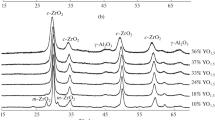Abstract
The Y–Ti hydrides nanoparticles were prepared by hydrogen plasma-metal reaction (HPMR) method. Transmission electron microscopy (TEM) observation revealed that they were spherical in shape and ranged from 5 to 75 nm with a mean diameter of 31 nm. Each nanoparticle contained different hydride phases (YH2, YH3 and TiH1.924), and there existed dislocations to relax lattice misfit strain and minimize the interfacial energy. The hydride nanocomposite started to oxidize at 218 °C during annealing in air, and the pyrochlore-type Y2Ti2O7 nanoparticles of single crystalline were fabricated successfully at a low sintering temperature of 900 °C for 1 h. The Y2Ti2O7 nanoparticles of axiolitic shape had an average size of 70 nm, much smaller than the conventional Y2Ti2O7 prepared by sintering Y and Ti oxides above 1300 °C. The formation of Y2Ti2O7 nanoparticles from the hydride nanocomposite at a low temperature and short reaction time can be attributed to the very short diffusion distance of Y and Ti at nanoscale, and the accelerated diffusion rate due to the strained interface of different hydride phases. The novel strategy opens a new way to prepare the nanosized pyrochlore-type oxides at a low temperature.







Similar content being viewed by others
References
Subramanian MA, Aravamudan G, Subba Rao GV (1983) Oxide pyrochlores—a review. Prog Solid State Chem 15:55–143
Erickson EE, Gray D, Taylor K et al (2002) Synthesis, structure and dielectric characterization of Ln2Ti2−2x M2x O7 (Ln = Gd, Er; M = Zr, Sn, Si). Mater Res Bull 37:2077–2083
Stanek CR, Grimes RW (2002) Prediction of rare-earth A2Hf2O7 pyrochlore phases. J Am Ceram Soc 85:2139–2141
Kramer SA, Tuller HL (1995) A novel titanate-based oxygen ion conductor: Gd2Ti2O7. Solid State Ionics 82:15–23
Jung D (2011) Factors affecting the superconducting transition temperatures of β-pyrochlore oxides AOs2O6 (A = K, Rb and Cs). Bull Korean Chem Soc 32:451–454
Vanderah TA (2002) Talking ceramics. Science 298:1182–1184
Porat O, Heremans H, Tuller HL (1997) Stability and mixed ionic electronic conduction in Gd2(Ti1−x Mo x )2O7 under anodic conditions. Solid State Ionics 94:75–83
Ishida S, Ren F, Takeuchi N (1993) New yellow ceramic pigment based on codoping pyrochlore-type Y2Ti2O7 with V5+ and Ca2+. J Am Ceram Soc 76:2644–2648
Xiao HY, Gao F, Weber WJ (2010) Threshold displacement energies and defect formation energies in Y2Ti2O7. J Phys: Condens Matter 22:1–9
Liu T, Wang CX, Shen HL, Cao YR (2015) Influence of YH2 nanoparticles addition on the microstructure and mechanical properties of oxide dispersion strengthened ferritic alloys. Adv Eng Mater 17:689
Li YH, Wang YQ, Valdez JA et al (2012) Swelling effects in Y2Ti2O7 pyrochlore irradiated with 400 keV Ne2+ ions. Nucl Instrum Meth B 274:182–187
Jenouvrier P, Boccardi G, Fick J et al (2005) Up-conversion emission in rare earth-doped Y2Ti2O7 sol–gel thin films. J Lumin 113:291–300
Zhang G, Song F, Ming CG et al (2012) Photoluminescence properties and pump-saturation effect of Er3+/Yb3+ co-doped Y2Ti2O7 nanocrystals. J Lumin 132:774–779
Chen BJ, Lin L, Li XJ et al (2009) Optical properties of Eu3+ in transparent Y–Ti–O nanocrystallized sol–gel film. J Alloy Compd 485:5–8
Gill JK, Pandey OP, Singh K (2011) Role of sintering temperature on thermal, electrical and structural properties of Y2Ti2O7 pyrochlores. Int J Hydrogen Energy 36:14943–14947
Hector AL, Wiggin SB (2004) Synthesis and structural study of stoichiometric Bi2Ti2O7 pyrochlore. J Solid State Chem 177:139–145
Lin KM, Lin CC, Hsiao CY et al (2007) Synthesis of Gd2Ti2O7: Eu3+, V4+ phosphors by sol–gel process and its luminescent properties. J Lumin 127:561–567
Chen ZS, Gong WP, Chen TF et al (2011) Synthesis and characterization of pyrochlore-type yttrium titanate nanoparticles by modified sol–gel method. Bull Mater Sci 34:429–434
Liu T, Cao YR, Qin CG et al (2014) Synthesis and hydrogen storage properties of Mg–10.6La–3.5Ni nanoparticles. J Power Sources 246:277–282
Liu T, Zhang TW, Qin CG et al (2011) Improved hydrogen storage properties of Mg–V nanoparticles prepared by hydrogen plasma-metal reaction. J Power Sources 196:9599–9604
Liu T, Cao YR, Zhu M et al (2013) Preparation and optical properties of YH2:Er2+ and Y2O3:Er3+ nanoparticles. J Nanosci Nanotechnol 13(6):3959–3965
Gill JK, Pandey OP, Singh K (2012) Ionic conductivity, structural and thermal properties of Ca2+ doped Y2Ti2O7 pyrochlores for SOFC. Int J Hydrogen Energy 37:3857–3864
He LF, Shirahata J, Nakayama T et al (2011) Mechanical properties of Y2Ti2O7. Scr Mater 64:548–551
Li GZ, Yu M, Wang RS et al (2006) Fabrication and photoluminescence properties of core–shell structured spherical SiO2@Gd2Ti2O7: Eu3+ phosphors. J Mater Res 21:2232
Wang XF, Chertihin GV, Andrews L (2002) Matrix infrared spectra and DFT calculations of the reactive MH x (x = 1, 2, and 3), (H2) MH2, MH2 +, and MH4 − (M = Sc, Y, and La) species. J Phys Chem A 106:9213–9225
Acknowledgements
The authors acknowledge the support of this work by the Joint Fund of the National Natural Science Foundation of China and Baosteel Group Corporation (No. U1560106), the Aeronautical Science Foundation of China (No. 2014ZF51069), and the Scientific Research Foundation for the Returned Overseas Chinese Scholars, State Education Ministry.
Author information
Authors and Affiliations
Corresponding author
Rights and permissions
About this article
Cite this article
Wang, L., Liu, T., Bai, Z. et al. Synthesis and characterization of Y2Ti2O7 nanoparticles from Y–Ti hydride nanocomposite at a low sintering temperature. J Mater Sci 51, 6967–6973 (2016). https://doi.org/10.1007/s10853-016-9985-5
Received:
Accepted:
Published:
Issue Date:
DOI: https://doi.org/10.1007/s10853-016-9985-5




